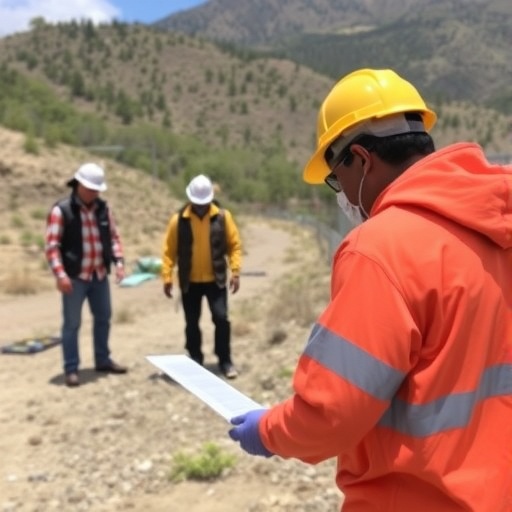In a groundbreaking study, researchers have unveiled a refined methodology for collection-unit surveys in archaeological projects, focusing on the Maharal Valley. This innovative approach seeks to enhance the effectiveness of archaeological field studies, providing robust frameworks to better identify and analyze ancient artifacts. This advancement is particularly significant given the increasing complexity and scale of archaeological endeavors in regions rich in historical significance.
The Maharal Valley project serves as a pivotal case study, showcasing the meticulous processes involved in archaeological surveys. Archaeologists often face the challenge of effectively documenting artifacts to glean insights into historical narratives. The research conducted by Jaffe, Kletzerman, and Barmatov-Paz introduces a systematic approach to survey methodologies that allow for more accurate data collection while minimizing gaps in evidence. Such refinements could have implications far beyond the Maharal Valley, influencing best practices in archaeological methodology globally.
The team employed rigorous field testing to evaluate their proposed methodology. This involved the deployment of diverse sampling techniques across various terrains to determine the most effective methods for artifact recovery. By analyzing the conditions under which specific artifacts were discovered, the researchers identified correlations between landscape features and artifact distribution. This data is invaluable, as it leads to a deeper understanding of how ancient cultures interacted with their environments.
A key component of the new methodology is its adaptability. Researchers can tailor the approach based on specific archaeological contexts, allowing for greater flexibility in fieldwork. This adaptability is vital as archaeological sites often present unique challenges that can hinder traditional survey methods. By embracing a more fluid framework, archaeologists can engage more effectively with the physical landscape and uncover valuable historical insights.
Moreover, the researchers emphasized the vital role of interdisciplinary collaboration in optimizing survey techniques. The integration of geological, ecological, and cultural studies can enhance the context in which artifacts are understood. By fostering a collaborative environment, archaeologists can create a holistic picture of past human activities and societal structures. The findings underscore the necessity of breaking down disciplinary silos to enrich the narrative of our shared history.
The study also highlights the importance of technological advancements in shaping modern archaeological practices. The incorporation of Geographic Information Systems (GIS) and remote sensing tools has revolutionized how surveys are conducted. The Maharal Valley project utilized these technologies to overlay archaeological data with environmental variables, providing richer contextual frameworks for interpreting artifacts. This melding of traditional archaeology with modern technology continues to redefine the boundaries of the discipline.
In addition to theoretical advancements, the research provides practical recommendations for implementing the refined survey methodology in future archaeological projects. The authors propose a variety of field techniques that can be employed in different scenarios, ensuring that archaeologists can effectively adapt their strategies to diverse conditions. Such recommendations are crucial in an era where archaeological projects face budget constraints and time limitations, necessitating efficient yet thorough methodologies.
The implications of this study extend beyond the immediate realm of archaeology. Understanding historical human behavior, societal changes, and environmental interactions is vital for addressing contemporary issues such as climate change and cultural preservation. As archaeologists delineate the complex narratives of the past, they equip modern societies with knowledge that informs current and future decision-making processes.
In the broader context of heritage management, the refined survey methods advocate for more sustainable and responsible practices in archaeological interventions. As sites increasingly face threats from urban development and ecological changes, the ability to accurately document and assess archaeological remains is imperative for safeguarding cultural heritage. This study serves as a clarion call for archaeologists and policymakers alike to prioritize the preservation of our irreplaceable historical landscapes.
As the field of archaeology evolves, the introduction of new methodologies will inevitably spur further research. The Maharal Valley project sets a benchmark for future studies, encouraging other researchers to adopt and adapt these innovative practices. The potential for cross-pollination of ideas across different archaeological contexts could yield transformative findings that deepen our understanding of past civilizations.
Furthermore, public engagement in archaeology is becoming paramount, as community involvement can enhance the effectiveness of surveys. The researchers advocate for educational initiatives that encourage local populations to participate in archaeological processes, thereby fostering a sense of ownership over their heritage. By involving community members, archaeologists can not only enrich their research but also promote cultural heritage awareness.
In conclusion, the research presented in this study is a significant advancement in archaeological methodology, offering new strategies for artifact recovery and analysis. The lessons learned from the Maharal Valley project will undoubtedly resonate across the discipline, influencing how future archaeological surveys are conducted around the world. As scholars continue to refine their techniques and practices, the stories of our shared human past will become ever clearer, providing a more nuanced understanding of who we are and where we come from.
This exploration of the Maharal Valley reaffirms the importance of innovation in archaeology. As researchers embark on this new frontier of survey methodologies, they not only honor the artifacts of the past but also pave the way for a sustainable future of archaeological inquiry.
Subject of Research: Refining collection-unit survey methodology in archaeology.
Article Title: Refining collection-unit survey methodology: the Maharal Valley project case study.
Article References:
Jaffe, Y., Kletzerman, M., Barmatov-Paz, G. et al. Refining collection-unit survey methodology: the Maharal Valley project case study.
Archaeol Anthropol Sci 17, 213 (2025). https://doi.org/10.1007/s12520-025-02337-w
Image Credits: AI Generated
DOI: https://doi.org/10.1007/s12520-025-02337-w
Keywords: Archaeology, Survey Methodology, Collection Units, Maharal Valley, Artifact Recovery, Interdisciplinary Collaboration, Geographic Information Systems, Environmental Interactions, Cultural Heritage Preservation.




